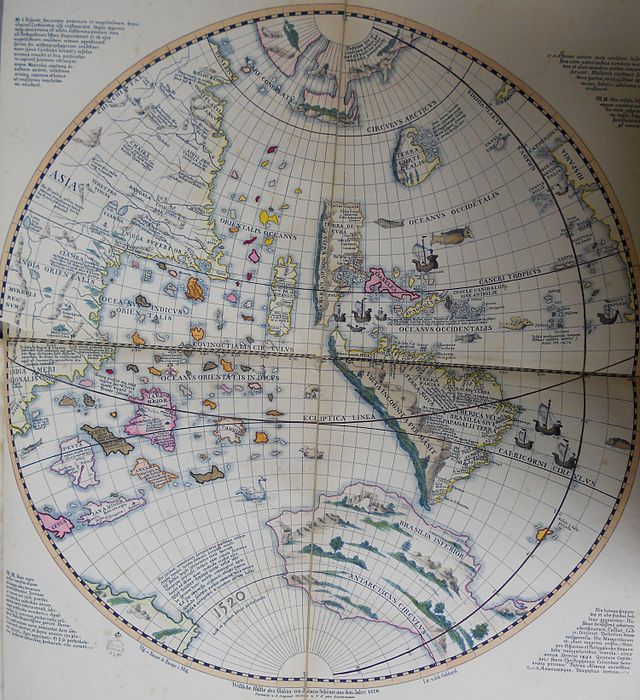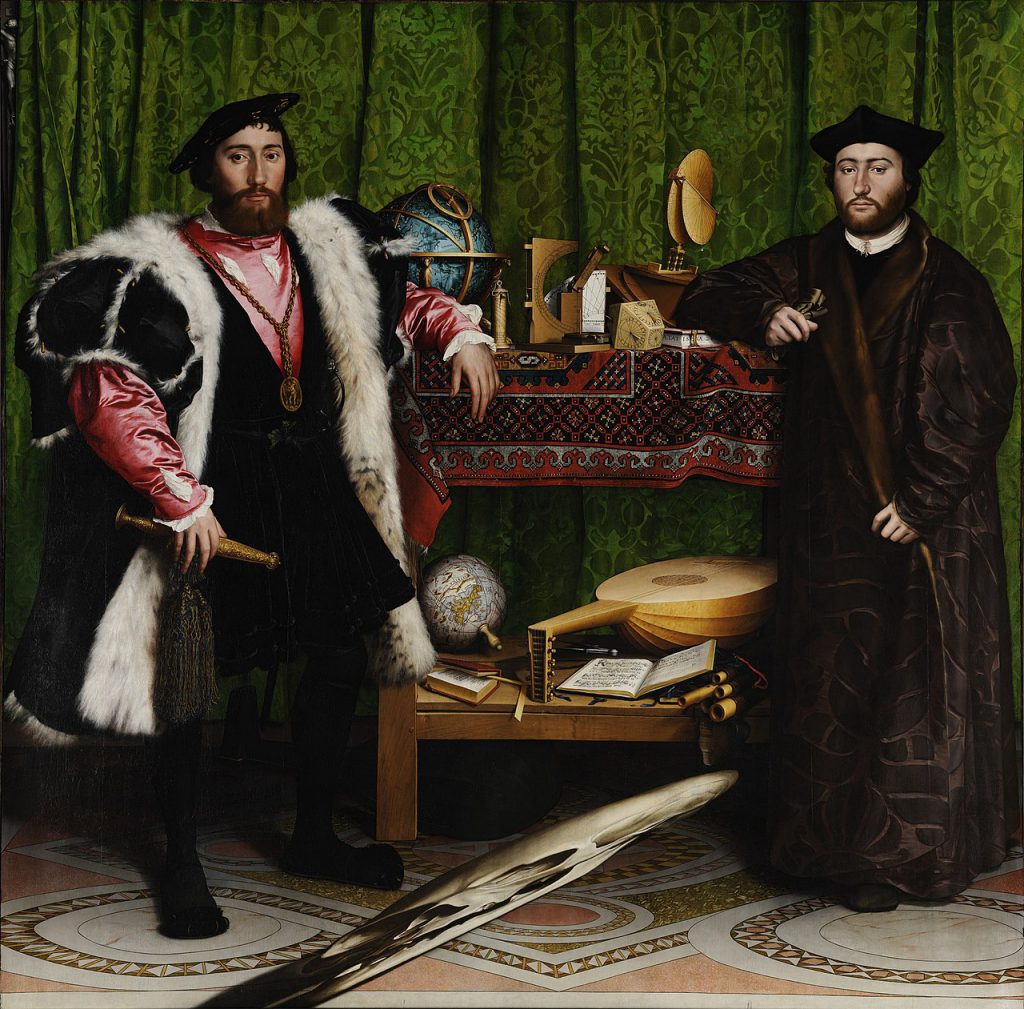
Johannes Schöner, aka Joan Schoenerus (1477-1547)
On January 16, 1477, German polymath Johannes Schöner was born. He was a priest, astronomer, astrologer, geographer, cosmographer, cartographer, mathematician, globe and scientific instrument maker and editor and publisher of scientific tests. He is well known for making and printing geographical globes, notably his 1515 globe which is one of the earliest surviving globes produced following the discovery of new lands by Christopher Columbus.
“Himmelan hat er dein Ziel
Selbst hinaufgestellt.
Sorg nicht mutlos, nicht zu viel
Um den Tand der Welt!
Flieh diesen Sinn,
Nur was du dem Himmel lebst,
Dir von Schätzen dort erstrebst,
Das ist Gewinn.”“Heavenly he has your goal
I put it up myself.
Don’t be discouraged, not too much
To the brink of the world!
Flee this sense,
Only what you’re living in the sky,
…from the treasures there,
That’s profit.”
– Johannes Schöner
Johannes Schöner – Early Years
Schöner was born in Karlstadt am Main in Lower Franconia. As with most other Renaissance scholars nothing is known about his parents or his early life. Quite detailed information for Schöner’s adult life, at least up to 1506, has been preserved in his own marginalia in his copy of Regiomontanus‘ printed Ephemerides, which he used as a diary. He matriculated at the University of Erfurt in 1494 and graduated Baccalaureus on 21 March 1498. He was appointed to a position in the school in Gemünden in 1499 and ordained as a Catholic priest in the Bishopric of Bamberg. His next appointment was as vicar in his hometown Karlstadt from 4 June 1504.
Waldseemüller’s Pupil
He was a pupil of the famous cartographer Martin Waldseemüller, who is credited with the first recorded usage of the word America, on the 1507 map Universalis Cosmographia in honour of the Florentine explorer Amerigo Vespucci.[3] No diary exists after 1506, and up to 1515 there are only indirect traces of Schöner’s existence. Because he neglected his offices as a priest and his concubinage with Kunigunde Holocher in 1499, with whom he had three children, he was sent to Kirchehrenbach in Franconian Switzerland for disciplinary reasons, where he remained at least until 1525.[2] 1526, he was called to Nürnberg as the first professor of mathematics at the newly founded gymnasium Aegidianum, a post he held till one year prior to his death in 1590. At the same time, he also converted to Protestantism and married his longterm relationship.

Johannes Schöner, Algorithmus demonstratus, 1534
First Famous Globes
Already in Bamberg, he owned his own printing company and published astronomical writings, maps and globes. The very first printed globe of the sky was made in his workshop in 1515. He made another globe in 1520 and in 1533. On his globes, Brasilia inferior is depicted seperated by a waterway from South America, i.e. before the “official” discovery by Portuguese explorer Ferdinand Magellan in November 1520.[4, 10] His depiction corresponded to the map created by the Osman Admiral Piri Reis in 1513. Schöner’s first scientific publication also was published in 1515 in Bamberg, entiteled Horari cylindri canones (Instructions on how to draw sundials on cylinders). Also in Bamberg, he published a treaty on Computus Ecclesiasticus, where he emphasized the necessity of a reformation of the old Julian calendar.

Western hemisphere of the Schöner globe from 1520
Publishing Heliocentric Astronomy
In 1538, Georg Joachim Rheticus, a young professor of mathematics at Wittenberg, stayed for some time with Schöner to be adviced by his profound knowledge in astronomy as well as astrology. Schöner convinced young Rheticus to visit Nicolaus Copernicus in Frauenburg,[4,6] to win Copernicus‘ books for publication in Nuremberg. In 1540, Rheticus dedicated the first published report of Copernicus work, the Narratio prima, to Schöner. As this was well received, Copernicus finally agreed to publish his main work, and Rheticus prepared Copernicus‘ manuscript for printing.

Jean de Dinteville, French Ambassador to the court of Henry VIII of England, and Georges de Selve, Bishop of Lavaur. The famous painting contains a celestial globe, which is definitely from Schöner and a terrestrial globe, which is probably from him.[10]
Further Publications
Schöner also published numerous calendars and prophecies, which reached high circulation. In his later years, he focussed more on astrology and published a beginner’s textbook Opusculum Astrologicum (1539) as well as the monograph De iudiciis nativitatum Libri Tres (1545). In Nürnberg, Schöner published in 1544 the astronomical observations in the rebate of Regiomontanus [6] and Bernhard Walther. He himself mainly dealt with gnomonics, to which he dedicated two works, one in German, one in Latin, both published in Nuremberg in 1562. The latter was accompanied by several other independent works, one dealing with the production of the astrolabe, the other with the drawing of the midday line; the author wanted the latter task to be solved without any help from the compass. Schöner edited several publications of Regiomontanus – especially his De Triangulis omnimodus (On Triangles), one of the first textbooks presenting the current state of trigonometry. From 1539 to 1541, Schöner improved the map of the Nuremberg region, previously produced by Erhart Etzlaub.
Jim Bennet, Introducing the Celestial Globe made by Johannes Schoener, [11]
References and Further Reading:
- [1] Johannes Schöner in Nuremberg, at The Museum of the History of Science
- [2] Amerigo Vespucci and the New World, SciHi Blog
- [3] Ferdinand Magellan and the first Trip around the World, SciHi Blog
- [4] Georg Joachim Rheticus’ Achievements for Astronomy, SciHi Blog
- [5] Nikolaus Copernicus and the Heliocentric Model, SciHi Blog
- [6] Regiomontanus – Forerunner of Modern Astronomy, SciHi Blog
- [7] Johannes Schöner at Wikidata
- [8] Siegmund Günther: Schöner, Andreas. In: Allgemeine Deutsche Biographie (ADB). Band 32, Duncker & Humblot, Leipzig 1891, S. 294 f.
- [9] Johannes Schöner: Opera mathematica Ioannis Schoneri in vnvm volvmen congesta …
- [10] Circumnavigating the Globe, at rmathematicus, May 15, 2010
- [11] Jim Bennet, Introducing the Celestial Globe made by Johannes Schoener, History of Science Museum @ youtube
- [12] Timeline of German Cartographers, via DBpedia and Wikidata





